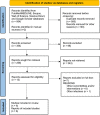The role of the CX3CL1/CX3CR1 axis as potential inflammatory biomarkers in subjects with periodontitis and rheumatoid arthritis: A systematic review
- PMID: 38415821
- PMCID: PMC10845211
- DOI: 10.1002/iid3.1181
The role of the CX3CL1/CX3CR1 axis as potential inflammatory biomarkers in subjects with periodontitis and rheumatoid arthritis: A systematic review
Abstract
Objective: This systematic review aimed to investigate the role of the C-X3-C motif ligand 1/chemokine receptor 1 C-X3-C motif (CX3CL1/CX3CR1) axis in the pathogenesis of periodontitis. Furthermore, as a secondary objective, we determine whether the CX3CL1/CX3CR1 axis could be considered complementary to clinical parameters to distinguish between periodontitis and rheumatoid arthritis (RA) and/or systemically healthy subjects.
Methods: The protocol used for this review was registered in OSF (10.17605/OSF.IO/KU8FJ). This study was designed following Preferred Reporting Items for Systematic Review and Meta-Analysis guidelines. Records were identified using different search engines (PubMed/MEDLINE, Scopus, Science Direct, and Web of Science) from August 10, 2006, to September 15, 2023. The observational studies on human subjects diagnosed with periodontitis and RA and/or systemically healthy were selected to analyze CX3CL1 and CX3CR1 biomarkers. The methodological validity of the selected articles was assessed using NIH.
Results: Six articles were included. Biological samples (gingival crevicular fluid [GCF], saliva, gingival tissue biopsies, serum) from 379 subjects (n = 275 exposure group and n = 104 control group) were analyzed. Higher CX3CL1 and CX3CR1 chemokine levels were found in subjects with periodontitis and RA compared with periodontal and systemically healthy subjects.
Conclusion: Very few studies highlight the role of the CX3CL1/CX3CR1 axis in the pathogenesis of periodontitis; however, increased levels of these chemokines are observed in different biological samples (GCF, gingival tissue, saliva, and serum) from subjects with periodontitis and RA compared with their healthy controls. Future studies should focus on long-term follow-up of subjects and monitoring changes in cytokine levels before and after periodontal therapy to deduce an appropriate interval in health and disease conditions.
Keywords: CX3CL1; CX3CR1; biomarkers of inflammation; chemokines; fractalkine; periodontitis; rheumatoid arthritis.
© 2024 The Authors. Immunity, Inflammation and Disease published by John Wiley & Sons Ltd.
Conflict of interest statement
The authors declare no conflict of interest.
Figures



Similar articles
-
Guided tissue regeneration for periodontal infra-bony defects.Cochrane Database Syst Rev. 2006 Apr 19;(2):CD001724. doi: 10.1002/14651858.CD001724.pub2. Cochrane Database Syst Rev. 2006. Update in: Cochrane Database Syst Rev. 2019 May 29;5:CD001724. doi: 10.1002/14651858.CD001724.pub3. PMID: 16625546 Updated.
-
Systemic pharmacological treatments for chronic plaque psoriasis: a network meta-analysis.Cochrane Database Syst Rev. 2021 Apr 19;4(4):CD011535. doi: 10.1002/14651858.CD011535.pub4. Cochrane Database Syst Rev. 2021. Update in: Cochrane Database Syst Rev. 2022 May 23;5:CD011535. doi: 10.1002/14651858.CD011535.pub5. PMID: 33871055 Free PMC article. Updated.
-
Metabolomics of gingival crevicular fluid to identify biomarkers for periodontitis: A systematic review with meta-analysis.J Periodontal Res. 2021 Aug;56(4):633-645. doi: 10.1111/jre.12872. Epub 2021 Mar 12. J Periodontal Res. 2021. PMID: 33710624
-
Resistin as potential biomarker for chronic periodontitis: A systematic review and meta-analysis.Arch Oral Biol. 2017 Jan;73:311-320. doi: 10.1016/j.archoralbio.2016.08.016. Epub 2016 Aug 17. Arch Oral Biol. 2017. PMID: 27567495
-
Do subjects with aggressive and chronic periodontitis exhibit a different cytokine/chemokine profile in the gingival crevicular fluid? A systematic review.J Periodontal Res. 2015 Feb;50(1):18-27. doi: 10.1111/jre.12180. Epub 2014 Mar 25. J Periodontal Res. 2015. PMID: 24665908
Cited by
-
Associations between Peritonsillar Abscess and Deep Neck Infection in Chronic Periodontitis Patients: Two Nested Case-Control Studies Using a National Health Screening Cohort.J Clin Med. 2024 Apr 9;13(8):2166. doi: 10.3390/jcm13082166. J Clin Med. 2024. PMID: 38673440 Free PMC article.
-
Cytokines profile in gingival crevicular fluid of subjects wearing fixed dental prostheses: a systematic review and meta-analysis.Eur J Med Res. 2024 Aug 29;29(1):437. doi: 10.1186/s40001-024-02031-y. Eur J Med Res. 2024. PMID: 39210386 Free PMC article.
-
Relationship Between MCP-1 Levels in GCF and Periodontitis: A Systematic Review With Meta-Analysis and Analysis of Molecular Interactions.J Cell Mol Med. 2025 May;29(9):e70545. doi: 10.1111/jcmm.70545. J Cell Mol Med. 2025. PMID: 40344491 Free PMC article. Review.
References
-
- Trindade D, Carvalho R, Machado V, Chambrone L, Mendes JJ, Botelho J. Prevalence of periodontitis in dentate people between 2011 and 2020: a systematic review and meta‐analysis of epidemiological studies. J Clin Periodontol. 2023;50(5):604‐626. - PubMed
-
- Tonetti MS, Greenwell H, Kornman KS. Staging and grading of periodontitis: framework and proposal of new classification and case definition. J Periodontol. 2018;45:S149‐S161. - PubMed
Publication types
MeSH terms
Substances
LinkOut - more resources
Full Text Sources
Medical
Research Materials
Miscellaneous

